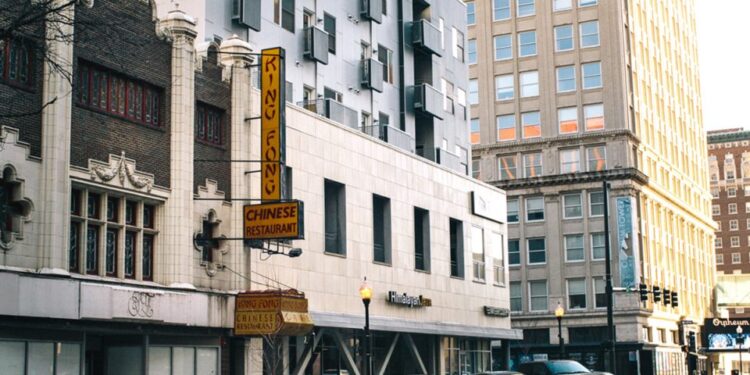To walk upstairs from 16th Street to the dining area of King Fong Cafe was like passing through a time-warp. Destination: Southern China, more than 100 years ago. Pagoda chandeliers hovered above lavish teakwood tables inlaid with mother-of-pearl. Golden camphor carvings decorated the trim of private booths and tearooms. Silken embroideries adorned walls.
But the cuisine was another sort of time-travel experience. At least until King Fong’s—considered Omaha’s oldest restaurant—closed “temporarily” for renovations in 2016. King Fong’s menu featured old-school Chinese-American dishes such as chop suey, chow mein, and egg foo young.
Back in the early days of Chinese immigration to the U.S., entrepreneurial chefs invented chop suey, chow mein, and egg foo young to appeal to American taste buds. The dishes became staples at Chinese restaurants throughout the United States, but they have gradually faded from Chinese-American menus in recent decades. The trend is evident in New York City’s Chinatown. Likewise among the Chinese restaurants of Omaha.
Omaha-born director Alexander Payne was involved in a company’s purchase of King Fong’s in 2007. He has expressed desire to ensure that a Chinese restaurant remains at the site of King Fong’s for future generations; however, the restaurant remained closed for renovations as this edition of Omaha Magazine headed to press.
Preservation of King Fong Cafe represents a continuation of the last-remaining continuous link to Omaha’s early Chinese community. The restaurant’s founder, Gin Chin, was born in California; Chin’s father was a potato farmer in Stockton who gained citizenship while working as a houseboy for the mayor of San Francisco. Chin eventually left California to open a Chinese restaurant in Duluth, Minnesota. Upon visiting Omaha for the 1896 Trans-Mississippi Exposition, he decided to relocate to Omaha’s relatively more-temperate climate. He opened the Mandarin Cafe and then King Fong Cafe in Omaha.
r
rr
| [soliloquy id="28059"] |
r
King Fong’s opened in 1920 at 315 S. 16th St. The building previously housed dining entrepreneur Tolf Hanson’s Cafe Beautiful, an ambitious French restaurant that ended up a financial disaster (the bankrupted Hanson committed suicide in 1909, a year after Cafe Beautiful opened). To remodel the magnificent space, Chin went all the way to Canton (present-day Guangdong province) to retrieve the traditional furniture and décor that would fill King Fong’s second and third levels. Chin even took the boat back to America with his teak tables, chandeliers, and silk embroideries to keep the investment safe.
Subsequent generations of the Chin family would leave the restaurant industry behind. Chin’s son, Carl (the eldest male of eight children), became a chemical engineer and chief chemist for Omaha Public Works. Although Carl personally helped out with accounting at King Fong’s, none of his own children would work there. Among Carl’s five children, his second-eldest son—Dennis Chin—is the only one still residing in Omaha. He became an accountant for Union Pacific before switching careers to education as a Bellevue school teacher/administrator and wrestling coach.
r
rr
| [soliloquy id="28046"] |
r
Dennis’s first language was Toisanese—a regional dialect of Cantonese—but says he’s no longer conversational in Chinese. His Chinese-American wife, Betty, grew up in Pittsburgh’s small Chinese community. Her first language was also Toisanese. Dennis and Betty (who remains bilingual) speak English with each other, their children, and granddaughter. Their household conversations demonstrate how English often becomes the language of familiarity for second and third-generations of Chinese-American families.
Just like the culinary landscape of Chinese-American communities has changed—with chop suey, chow mein, and egg foo young becoming increasingly rare—the linguistic landscape has also changed with subsequent waves of Chinese migration.
Mandarin has replaced Cantonese as the dominant Chinese language in Chinese-American communities. (Cantonese is the regional language/dialect of Guangdong province and the Hong Kong Special Administrative Region, while Mandarin is spoken throughout mainland China and Taiwan.)
Meanwhile, with recent waves of Chinese immigration, the great variety of Chinese cuisine has found more authentic representation in American cities: from Sichuanese (a spicy Chinese cuisine from the interior of the country, available in Omaha at China Garden), to Shandong specialties (available at Blue & Fly in Omaha), and even back south to the Cantonese-speaking region of China with authentic dim sum (available in Omaha at Gold Mountain’s two locations and Grand Fortune Chinese Restaurant).
r
This article was printed in the March/April 2018 edition of Omaha Magazine. Interior photos of King Fong's published in the September/October edition of Encounter Magazine.r
See other Omaha-Chinese content from the March/April 2018 edition of Omaha Magazine:
r
- r
- rAbout the cover of the print magazine
- Editor’s letter: “Year of the Dog”r
- r“Omaha’s Forgotten Chinatown (and the Continuation of Local Chinese Lunar New Year Celebrations)”
- “Chinatown Lost and Found: The On Leong Tong House”
- "A Timeline of Chinese in Omaha"
- Video: “Shopping for Chinese Lunar New Year”r
- Online exclusive: “A Revolutionary Meeting”r
r
r
r
r
r
r
r











